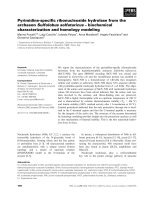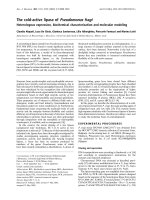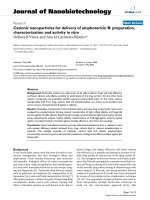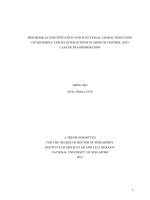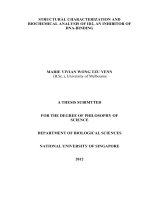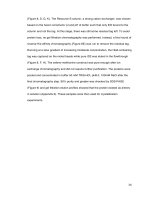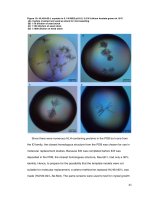Biochemical characterization and correlations in Brassica Juncea genotypes
Bạn đang xem bản rút gọn của tài liệu. Xem và tải ngay bản đầy đủ của tài liệu tại đây (262.87 KB, 10 trang )
Int.J.Curr.Microbiol.App.Sci (2019) 8(1): 2408-2417
International Journal of Current Microbiology and Applied Sciences
ISSN: 2319-7706 Volume 8 Number 01 (2019)
Journal homepage:
Original Research Article
/>
Biochemical Characterization and Correlations
in Brassica juncea Genotypes
Anubhuti Sharma1*, Manoj Aacharya2, H. Punetha3, Sanjula Sharma4,
Nisha Kumari5 and P.K. Rai1
1
Directorate of Rapeseed Mustard Research (ICAR), Sewar, Bharatpur 321303
(Rajasthan) India
2
CSKHP Agricultural University Shivalik Agricultural Research and Extension Centre
Kangra-176 001 (H.P.), India
3
G.B. Pant University of Agriculture and Technology, Pantnagar 263145 (Uttarakhand),
India
4
Punjab Agricultural University Ludhiana-141 004 (Punjab), India
5
CCS Haryana Agricultural University, Hissar-125 004 (Haryana), India
*Corresponding author
ABSTRACT
Keywords
Brassica juncea,
Soxhlet method,
Glucosinolate,
Phytic acid
Article Info
Accepted:
17 December 2018
Available Online:
10 January 2019
Twenty four genotypes from germplasm were taken to evaluate oil content, oil
stability index, erucic acid, total glucosinolate content, total protein content
and phytic acid. The assayed genotypes contained 35.54% to 40.96 % oil
content, 0.79 to 1.34 oil stability index, 0.31% to 49.79 % erucic acid, 16.20 to
103.96 μmol/g total glucosinolate content of defatted seedmeal, 34.86% to
38.79% protein content and 1.77% to 2.84% phytic acid. The objective of this
work is to characterize and correlate the biochemical parameters for
neutraceutical study in brassica. The study confirmed the significant genetic
variability in brassica kernels with respect to oil content, glucosinolates, total
protein, omega ratio, oil stability index and phytic acid.
Introduction
Identification of germplasm with rich
nutritional profile is very much essential for
eradicating the problem of malnutrition
globally. In recent years, consumer’s view has
undergone a drastic change as of now they are
not only concerned about what they eat but
also on the impact of consumed ingredients on
their health. One of the important components
in our diets is oil which is the most
concentrated source of energy. In India, major
contributors towards vegetable oils are
rapeseed-mustard (31%), soybean (26%) and
groundnut (24%). Other crops viz., sunflower,
sesame and safflower contribute only 18%
2408
Int.J.Curr.Microbiol.App.Sci (2019) 8(1): 2408-2417
towards vegetable oil (DAC 2017). The oil
utilization, whether for edible (cooking) or
non-edible (industrial) purpose, solely
depends upon its fatty acid profile. The oil to
be used for edible purpose has to follow
certain guidelines as recommended by global
health agencies.
As per American Heart Association (AHA)
and WHO/FAO recommendations, saturated
fatty acids (SFA) should not be above 10 %.
Out of so many vegetable oils available in
market, only mustard fulfills the requirement
as it has around 2.5-8.6% of SFA (palmitic
C16:0 + stearic C18:0).Apart from this, mustard
oil also contains oleic (C18:1), linoleic (C18:2;
ω6), linolenic (C18:3; ω3), eicosenoic (C20:1)
and erucic acid (C22:1). Linoleic and linolenic
are essential fatty acids that are not
synthesized by our body.
Another important recommendation to judge
the quality of oil is ω6: ω3 ratio which should
lie between 5:1 to 10:1 (Johnson and Saikia
2009). Mustard oil fits well to this
recommended range. Erucic acid is feared to
be an agent of cardiac problems and should be
less than 2 % in edible oil as per guidelines of
WHO. High level of erucic acid is of
industrial use. Development of canola type
(containing less than 2 % erucic acid in oil and
less than 30 µmoles glucosinolates per gram
defatted oilseed meal) varieties is a great
achievement of Brassica breeders.
The mustard defatted meal is used as animal
feed. It contains various phenolic compounds
(bioactive secondary plant metabolites)
including polyphenols, carotenoids and
flavonoids (Ballesta et al., 2015) that
contribute to diverse nutraceutical potential
such as antimicrobial, antioxidant, antiinflammatory, antitumor and anti-carcinogenic
effects (Sharma et al., 2016). Besides fats they
contain vitamins, minerals, fibre and also a
large number of novel phytochemicals, some
of which provide protection
carcinogenesis (Seyis 2012).
against
The cake is also a rich source of proteins (3540%). However, still it is not preferred as
protein supplement to animals to eliminate
protein malnutrition due to presence of some
anti-nutritional
compounds
viz.,
Glucosinolates (2-3%), Tannin (1.6-3.1%),
Sinapine (1-1.5%), Phytic acid (3-6%). All
these constituents are known to adversely
affect the health of humans and animals. There
is need for upgrading the cakes for further
incorporation into foods and food products.
One of the major important objectives of the
Brassica breeding programme in India is to
improve oil and seed meal quality and a lot of
progress has already been made and still being
made by the rapeseed-mustard breeders with
the development of double low “00” Indian
mustard varieties with erucic acid <2 % and
glucosinolate content <30 μmole/g in defatted
seed meal and also to achieve the balanced
ratio of SFA/MUFA/PUFA and ω6/ω3.
During the last 10 years, a significant interest
have also aroused among the scientists in
bioactive compounds present in many plants
and food materials with strong antioxidant
activity to reduce the free radical production
that causes cell damage in the biological
process (Sharma et al., 2017).
During 2017-18, a large number of germplasm
were tested under All India Cordinated
Research Project on Rapeseed Mustard
(AICRP-RM) programme for quality traits viz
oil content, fatty acid profiling, ω6:ω3 ratio,
oil stability index (18:1/18:2). Seed meal of
these genotypes were also evaluated for
protein, limiting amino acids viz, methionine
and tryptophan, phytic acid, total antioxidant
activity, DPPH free radical scavenging
activity, total flavanoids and β-carotene
content.
2409
Int.J.Curr.Microbiol.App.Sci (2019) 8(1): 2408-2417
Materials and Methods
Source of plant material
The seed samples of twenty four of IVT/AVT
entries from AICRP-RM trials (2017-18) were
used for various estimations. The estimations
was done separately at five locations i.e.
Bharatpur, Ludhiana, Hissar, Kangra, and
Pantnagar,
Estimation of oil by Soxhlet method
Finely crushed weighed seed material of 2g
was put into a thimble and placed into the
extractor of soxhlet apparatus after placing
cotton at the bottom. A piece of cotton was
placed at the top to evenly distribute the
solvent as it dropped on the sample during
extraction. Petroleum ether was added in the
flask and extracted the oil for six hours
(AOAC 1970). Allowed to cool and
evaporated on water bath to remove last traces
of the solvent. Kept the extraction flask in
oven at 700C for 10 min, then transferred it to
desiccator and cooled at room temperature.
Weighed the flask and repeated the heating
and cooling until constant weight was
achieved.
Estimation fatty acid methyl esters on GC
2 ml toluene and 4 ml dried methanolic-H2SO4
(99:1) were added to 20 mg oil sample,
vortexed and passed N2 for 2 minutes to get rid
off moisture (Christie, 1990). Refluxed for 12
hrs at 50oC and cooled, then added 2 ml NaCl
(4 %) solution, 2ml KCl (4%) solution and 20
ml n-Hexane. Vortexed and separated out nHexane layer. Added 4 ml Na2CO3 (4 %)/KCL
(4%) solution, vortexed and separated out
hexane layer. Concentrated to one layer on
vacuum using roto evaporator and injected 1μl
of upper layer in split mode to injection port
(2300C) of GC equipped with ramps having
column BP-20 (SGE) at 225 to 2500 Cusing N2
as carrier gas and detected peak with the help
of FID detector at 2500C.GC was calibrated
with standards of methyl ester of palmitic,
stearic, oleic, linoleic linolenic, eicosenoic and
erucic acid.
Determination of
kjeldahl’s method
protein
by
micro-
Weighed 100mg of the sample, transferred to
a 30ml digestion flask. Add 1.9±0.1g
potassium sulphate and 80±10mg mercuric
oxide and 2ml conc (AOAC 1965) H2SO4 to
the digestion flask. Boiling chips were also
added and sample was digested till the
solution becomes colourless. After cooling the
digest, diluted it with a very small quantity of
distilled ammonia-free water and transferred
to the distillation apparatus. The Kjeldahl
flask was then rinsed with successive small
quantities of water. Place a 100 ml conical
flask containing 5ml boric acid solution and a
few drops of indicator with the tip of the
condenser dipping below the surface of the
solution. Add 10ml of sodium hydroxidesodium thiosulphate solution to the test
solution in the apparatus. After distillation
collect 15 ml ammonia on boric acid. Rinsed
the tip of the condenser and titrate the solution
against the standard acid until the first
appearance of violet colour. Run a reagent
blank with an equal volume of distilled water
and subtracted the titration volume from that
of sample titer volume.
Estimation of glucosinolate content by tetra
chloropalladate method
200mg oven dried seeds were crushed then
transferred to screw-capped tubes and kept
overnight at 50°C (Kumar et al., 2004). Add
300ml of 80 % methyl alcohol in to the tubes.
Keep the tubes on water bath at 70oC for 5
min. After cooling added 2 ml double distilled
water. Centrifuge at 5000 rpm for 5 minute.
Take 5 µl of supernatant from upper layer on
2410
Int.J.Curr.Microbiol.App.Sci (2019) 8(1): 2408-2417
ELISA plate. Add 300 μl of 0.002M sodium
tetra chloropalladate. Mixed and put in oven at
70oC for 30 minute. Read at 405 nm on
ELISA READER.
Estimation of Phytic acid
Freshly ground sample (0.5 g) was extracted
with 25 ml of 0.2 N HCL for 3 hrs on a shaker
(Haug et al., 1983). After shaking, it was
filtered through Whatman No. 1 filter paper.
An aliquot (0.5 ml) of the above extracted
sample was taken in a test tube and 0.9 ml of
distilled water was added. To all the tubes add
1 ml of ferric ammonium sulphate was added
and then placed in boiling water bath for 30
minutes. One ml of the supernatant was
transferred to another test tube and added 1.5
ml of bipyridine solution. The absorbance was
measured at 519 nm against distilled water as
blank. Different concentration of Sodium
Phytate solution containing 30 to 50µg of
Phytic acid was taken to make standard curve.
Statistical Analysis
All experiments were performed in triplicate.
Data obtained were analyzed.
Results and Discussion
Biochemical traits exhibited broad variability
among the different entries used in the current
study (Table 1). The oil content ranged from
35.54% (LES-54) to 40.96 % (KRANTI). The
promising genotypes having high oil content
were KRANTI (40.96 %), NRCHB-101
(40.16 %). The present findings are similar as
reported earlier (Prem et al., 2012). The oil
stabilty index is the ratio of oleic acid to
linoleic acid. Higher the OSI, longer is the
shelf life of oil. The range of OSI varied
from 0.79 (LES-54) to 1.34 (RL-1359(ZC). In
the present study the promising genotypes
having high OSI were RL-1359(ZC), RH749(ZC),
PDZ-5,
PDZ-1.
The
gas
chromatographic analysis revealed that erucic
acid in the mustard oil of various genotypes
was in the range from 0.31% (CJRB-1661) to
49.79 % (RL-1359. The genotypes of quality
mustard having erucic acid ˂ 2% were PM-29,
LES-54, LES-55, PM-30, PDZ-7, CJRB-1661,
PDZ-8, RLC-2, PDZ-4, PM-21, PDZ-1, PDZ5, PM-29 and RLC-3. High erucic acid
content reported to be undesirable for human
consumption leading to fibrotic changes in
myocardium and increased adrenal cholesterol
level
(Aaes-Jorgensen
1972).
The
glucosinolate content varied from 16.20 to
103.96 μmol/g (KRANTI). The promising
genotypes having glucosinolate content less
than 30μmol/g were CJRB-1661, PDZ-8,
PDZ-4,
PDZ-1,
PDZ-5,
RLC-3.
Glucosinolate degradation forms various
degradative products as per the ambient
conditions like isothiocyanates. The high
intake of Brassica vegetables is directly
associated with a decreased risk of cancer
of the lung, stomach, colon, and rectum due
to the presence of glucosinolates (Poppel et
al., 1999). In India, oil obtained from
traditional mustard seed contains high
amounts of erucic acid (40-57%) and
glucosinolate (80-160 µmole) per gram of
defatted seed meal (Agnihotri and Kaushik
2002). Erucic acid and glucosinolates are antinutritional compounds having numerous ill
effects on health of humans as well as
animals, thus needed to be reduced to lower
acceptable limits for rendering it safe for
humans and animals consumption.
Omega ratio of none of the genotypes fall
under the recommended value of 5-10.
However, in present findings ω6: ω3 ratio was
fairly better in PDZ-1 (3.46), PM-29 (3.35),
PDZ-7 (3.16), PM-21 (3.13) and PDZ-8
(3.13). Same findings were reported by Kumar
et al., (2014), who compared ratios of
SFA/MUFA/PUFA and ω6/ω3 in Rapeseedmustard, Soyabean, Groundnut, Sunflower,
and found that no other oil contains suitable
2411
Int.J.Curr.Microbiol.App.Sci (2019) 8(1): 2408-2417
ratios of SFA/MUFA/ PUFA and ω6/ω3 ratios
as per international recommendations 1:1-3:1
and 5-10 respectively except brassica.
In the current study of twenty four genotypes
of Indian Mustard showed a significant
variation of protein content in a narrow range
from 34.86% to 38.79%. The promising
genotypes having high protein content were
PM-21 (38.22%), RLC-2 (38.48%), PM-30
(38.79%) and RGN-73(38.25%). Mustard
meal contains high protein content of
approximately 40% and a nutritional study
revealed that mustard protein has a remarkably
well-balanced amino acid composition (Etten
et al., 1967). The crude protein of defatted
mustard meal is of high biological value
having appreciable amount of albumin,
glutelin, globulin (Klockeman et al., 1997).
Phytate is very important compound used in
mineral storage, is a cation salt of phytic acid
(myo-inositol hexa phosphoric acid). In this
study phytic acid content was found to be
varied from 1.77% in LES-55 to 2.84% in
PM-30. Although it an anti-nutrient because it
chelates divalent minerals and reduces their
physiological availability (Hurrell, 2003), but
it also possesses positive nutritional role as it
acts as an anti-oxidant and anti-cancer
agent.The present investigation are in
agreement with the previous study reported
phytic acid from 0.9 to 12.8 g kg−1 in seed
meal (Lickfett et al., 2016) (Fig. 1).
Table.1 Pearson correlation
2412
Int.J.Curr.Microbiol.App.Sci (2019) 8(1): 2408-2417
Table.2 Eigen values of cluster analysis
Eigen values
Number Eigen
value
1
5.7305
2
0.9306
3
0.3389
4
0
5
0
6
0
7
0
Percent Percent
81.864
13.294
4.841
0
0
0
0
Cum
Percent
+++++++++ 81.864
+
95.159
100
100
100
100
100
Fig.1 Genotypes screening
2413
Chi
Square
1390.39
1193.17
1071.62
19.542
9.001
3.155
0
DF
Prob>ChiSq
16.444
19.332
13.954
9
4.999
1.999
.
<.0001
<.0001
<.0001
0.021
0.109
0.2064
.
Int.J.Curr.Microbiol.App.Sci (2019) 8(1): 2408-2417
Fig.2 PCA analysis (A & B)
Fig.3 Two way cluster analysis in brassica genotype
2414
Int.J.Curr.Microbiol.App.Sci (2019) 8(1): 2408-2417
Multivariate analysis
Principal Component Analysis (PCA) is a
useful statistical technique which has found
application in reduction of the original
variables in oil content, erucic acid, protein
content and contents to smaller number of
variables i.e. principal components which
reveal the interrelationships between the
different variables. The loading and scatter
plot of mustard genotypes were studied using
principal PCA and are shown in Figure 2(a)
and (b), respectively. In the PCA, the length,
direction and the angles between the lines
indicate correlation between the variables or
between variables and principal component
axes (e.g., α=0o and/or 180o and r=1; α=90o
and r=0). The first principal component (PC1)
had the highest Eigen value of 5.73 and
accounted for 81.9% variability in the data
set, while second principal component (PC2)
had eigen value of 0.93 and accounted for
13.3% variability (Table 2). All parameters
occupied the right side in the biplot. Further
among the parameters oil stability index
(OSI) and oil percent were observed on the
right upper side in the biplot with high
positive loading for both PC1 and PC2, while
phytic acid, glucosinolate (GSL), erucic acid,
total protein and omega ratio were observed
with slightly lesser positive loadings on the
right lower side of the biplot. The PCA
clearly suggests that phytic acid and GSL are
having significant positive correlation.
However, negative correlation was observed
between oil percent and phytic acid, GSL.
Similarly, it is also observed that most
promising genotypes with high amount of oil
stability index (OSI) and oil percent and low
amount of phytates occupies the upper right
side of the scatter plot of brassica genotypes
(Fig. 2b).
Correlations were computed among seven
biochemical parameters on data for 24
genotypes. The Pearson correlation indicates
that most of the variables have positive
correlation. Significant positive relationship
can be seen between phytic acid,
glucosinolates, total proteins and erucic acid
table 1 (>0.30). However moderate negative
correlation was observed between oil & total
protein content. The results suggest that all
the correlations were statistically significant
and were greater or equal to r=+.50, p <.05,
two-tailed.
Two way cluster analysis
The studied Indian mustard genotypes were
categorized based on their biochemical
constituents using the two way cluster
analysis which is shown in Figure 3. The twoway cluster analysis broadly separated the
brassica genotypes into three clusters. Among
these three clusters the cluster III which
contains RH-749, RGN-73, RGN-73, RL1359, NRCHB-101, Kranti were found with
higher amount of GSL, erucic acid, phytic
acid, total protein along with moderate
amount of oil index stability. The lowest
amount of GSL, erucic acid, phytic acid, total
protein were observed in cluster II which
contains LES-54, LES-55, PM-29, PDZ-8,
PDZ-6, PM-21. Cluster I (PM-30, RLC-2,
PDZ-7, RLC-3, CJRB-1661, PDZ-4, PDZ-1,
PDZ-5) was observed with the lowest content
of GSL compared to all other clusters.
In conclusion, the study confirmed the
significant genetic variability in brassica
kernels with respect to oil content,
glucosinolates, total protein, omega ratio, oil
stability index and PA. Among the studied
brassica genotypes PM-30, RLC-2, PDZ-7,
RLC-3, CJRB-1661, PDZ-4, PDZ-1, PDZ-5
were found with lower amount of gsl, erucic
acid, phytic acid, total protein along with
moderate amount of oil content.
The positive correlation between GSL, PA
and protein content revealed that concurrently
2415
Int.J.Curr.Microbiol.App.Sci (2019) 8(1): 2408-2417
improvements of these nutritional parameters
are possible. Further, substantial genetic
variability coupled with high heritability and
weak association of oil contents with
glucosinolate and phytate contents suggested
that it is possible to breed oil content dense
cultivars with low phytate contents.
Acknowledgement
The authors are grateful to Indian council of
Agricultural Research for funding the work
and the plant breeders for sharing seeds of
genotypes used in this study. The authors
have no conflict of interest.
References
Aaes-Jorgensen E (1972) Nutritional value of
rapeseed oil. pp. 301-353. In:
Rapeseed Cultivation, Composition,
Processing and Utilization, by
Appelqvist, L A and Ohlson R,
Elsevier, Amsterdam.
Agnihotri A and Kaushik N (2002) Quality
considerations in edible oilseeds:
rapeseed and mustard. In: Oilseeds
and oils: research and development
needs. Rai M, Singh H and Hedge,
DM (ed) Hyderabad, An Indian
Society
of
Oilseeds
Research
Publication: 315-326.
AOAC (1965) Official Methods of Analysis
of Association of Official Analytical
Chemists. 6th Edition, Washington,
D.C.
AOAC (1970) Official Methods of Analysis
of Association of Official Analytical
Chemists, 11th edn Washington, DC.
Christie WW (1990) Preparation of methyl
esters-Part 1. Lipid Tech, 2, 48.
DAC(2017) Directorate of Economics and
Statistics (DES), Department of
Agriculture and Cooperation (DAC)
and Department of Commerce (DoC)
Commodity Profile for Pulses-March,
2017(As on 24.03.2017). Pp. 9.
Etten C H, Kwolek WF, Peters JE, Barclay
AS (1967) Plant seeds as protein
source for food and feed: Evaluation
based on amino acid composition of
379 Species. J Agric Food Chem 53:
162-166.
Haug W and Lantzsch H J (1983) Sensitive
method for the rapid determination of
phytate in cereal and cereal products. J
Sci Food Agri 34(12): 1423-26.
Hurrell RF (2003) Influence of vegetable
protein sources on trace element and
mineral bioavailability. Nutrition
Journal 133: 2973S–2977S.
Johnson S and Saikia N (2009) Fatty acids
profile of edible oils and fats in India.
Centre for Science and Environment.
New Delhi, CSE: 32.
Klockeman DM, Toledo R and Sims KA
(1997) Isolation and characterization
of defatted canola meal protein. J
Agric Food Chem 45(10): 3867-3870.
Kumar S, Singh D and Dutta M (2014)
Quality characteristics in rapeseedmustard and role of some antinutritional factors in plant defense:
future strategies. J Oilseed Brassica 5:
87-95.
Kumar S, Yadav SK, Chauhan JS, Singh AK,
Khan NA and Kumar PR (2004)
Estimation by complex formation
between
glucosinolates
and
tetrachloropalladate (II) using ELISA
Reader. J Food Sci and Tech-Mysore
41: 63-65.
Lickfett T, Matthäus B, Velasco Land
Christian M ((1999) Seed yield, oil
and phytate concentration in the seeds
of two oilseed rape cultivars as
affected by different phosphorus
supply.
European
Journal
of
Agronomy 11: 293–299
Martínez-Ballesta M, Moreno-Fernández DA,
Castejón D, Ochando C, Morandini
2416
Int.J.Curr.Microbiol.App.Sci (2019) 8(1): 2408-2417
PA, Carvajal M (2015) The impact of
the absence of aliphatic glucosinolates
on water transport under salt stress in
Arabidopsis thaliana. Frontiers Plant
Sci.
6:524.
doi:10.3389/fpls.2015.00524.
Poppel VG, Verhoeven DT, Verhagen H,
Goldbohm RA (1999) Brassica
vegetables and cancer prevention,
Epidemiology and mechanisms. Adv
Exp Med Biol. 472: 159-168.
Prem D, Gupta K, Sarkar G and Agnihotri A
(2012) Determination of oil, protein
and moisture content in whole seeds
of three oleiferous Brassica species
using
near-infrared
reflectance
spectroscopy. Journal of Oilseed
Brassica 3(2): 88–98.
Seyis (2012) Towards a canola quality
resynthesized rapeseed (Brassica
napurs L.): B. oleracea genotypes as a
basic resource. The European Journal
of Plant Science and Biotechnology 7
(Special issue 1): 33-37.
Sharma A, Kumar A, Meena HS, Singh D
(2017)
Chromatographic
determination of Phenolics in Brassica
juncea L. Asian J. Chem. 29:296-300.
Sharma A, Sharma A, Yadav P, Singh D
(2016) Isothiocyanates in Brassica:
Potential Anti-Cancer Agents. Asian
Pac J Cancer Prev. 17(9):4507-451.
How to cite this article:
Anubhuti Sharma, Manoj Aacharya, H. Punetha, Sanjula Sharma, Nisha Kumari and Rai, P.K.
2019. Biochemical Characterization and Correlations in Brassica juncea Genotypes.
Int.J.Curr.Microbiol.App.Sci. 8(01): 2408-2417. doi: />
2417
